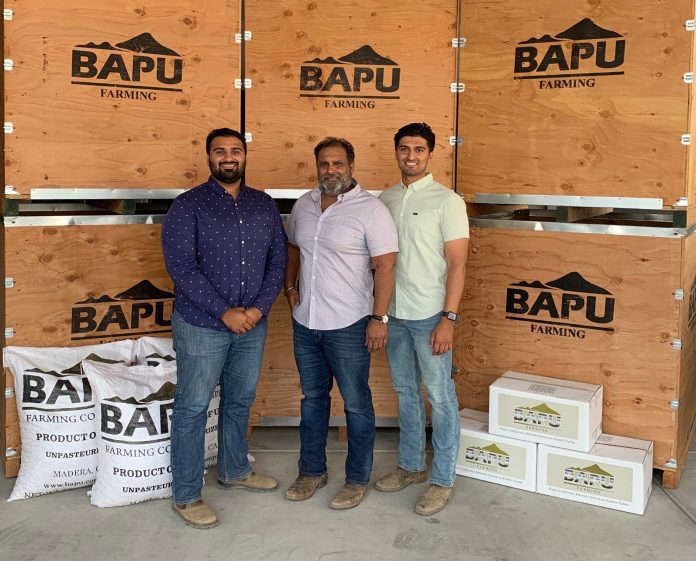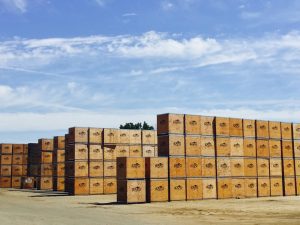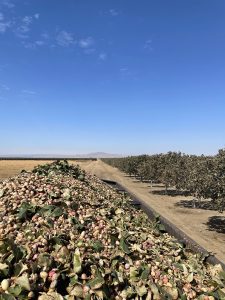
Like many children of farming parents, Karun Samran of Bapu Farming Co. and Bapu Almond Co. left his family farm to attend college. But unlike many of those children who leave for college, he chose to come back and join the family operation after he graduated in 2017 despite the appeal of better weather and more things to do in the Bay Area.
His decision came down to family expectations and the belief that farming held a host of opportunities to explore. He saw a chance to fill some of the vacuum being left by other family farms that were selling out. After returning home, he jumped into his role, exploring new farming practices like regenerative farming and getting involved in problem-solving the ever-present water situation.
West Coast Nut asked Samran to share some of his experiences and views on where the nut industry is going in the future.

Q. Tell us a little bit about your family history when it comes to farming.
My family immigrated here from Punjab, India back in the ‘70s, and they settled in Madera in the early ’80s. They started out as farm laborers and later became labor contractors. From there, they saved up to start buying farms and became full-time farmers. It’s the typical American Dream they achieved.
I went off to college, and my decision was always to come back. My dad was a one-man show, so I came back to help him out. I have a younger brother, and he also went out of the Valley for college, got his bachelor’s and came back. So now it’s the three of us in the operation.
We farm almonds, tomatoes, wine grapes and pistachios in Madera and Kern County. We’re pretty spread out and have a fair number of acres to deal with. On top of that, we have our own almond processor here in Madera.
When it comes to actual farming, we try to do what we can to be vertically integrated, so we have a lot of our own heavy machinery to do orchard removal and development, and we have tree grinding. We got into orchard removal as well because we saw four or five years ago there were going to be so many orchards out there that need to be grinded, and there were not going to be enough grinders out there. We did not want to have our farm developments held up waiting on others.

Q. Did you ever consider doing anything else or was it always, ‘I want to come back and be part of the farm?’
You do consider it; it’s hard not to. I went to UC Berkeley, but from the beginning, my dad always tried to emphasize to my brother and I that, ‘You guys need to come back; the Valley needs you.’ He’s seen it so often; in the Valley, we lose so many of our brighter minds to outside places. They leave because they don’t see the opportunity for change in the Valley, and that’s opened up a vacuum here.
My dad told us there’ll be a lot of opportunities because he saw it firsthand. I mean, more often than not, almost every ranch we buy is a family farmer’s last ranch because they didn’t have a succession plan. Someone sells out because they don’t have someone in their family who wanted to continue farming. That’s a trend you see across the nation.
Also, in our Sikh culture, if you have a family business, it’s expected for the kids to partake in the family business because there will be always a spot for them and to eventually take it over to continue over the generations.

Q. Can you talk a little bit about how you have seen farming practices evolve in the last several years?
It’s a lot more tech now, more than we know what to do with since it just exploded in the last 5 to 10 years. We’re sitting right next door to Silicon Valley, the hub of tech innovation, so it’s nice that we’re finally getting a little bit of that trickling down this way. That’s the biggest difference.
Tech has really helped the irrigation aspect of farming; now, you can get real-time readings and that can help you really effectively manage your irrigation and water. There’s water scarcity everywhere in the state, so you want to manage your water to a T.
There are also other things like smart sprayers that we have tech to thank for. We have a couple of those, and they’re really nice as we save a lot on inputs by using them. We don’t have any autonomous tractors or anything, but that looks like that’s going to be the next step. It’s still in the early phase. It’s a little bit cost-prohibitive for a big adoption, but I’m pretty sure eventually the price of that will come down, and next thing you know, almost everyone will have one in their fleet. Who knows, maybe in the next 10 to 15 years, it will be common to see them laying around just doing one repetitive task, so it frees up a farmer to do something else.
Q. Talk a little bit about the water situation and how that is impacting your plans now and going forward.
The water situation makes you think twice about what you want to plant. You have a bank account of water allocation. It’s going to be slowly, slowly, slowly cut back. So now we have this finite amount of water.
Even though our trees likely have another 10 years of life left, we have to focus on surviving right now. The almond economics have been depressed for the last couple of years, and it doesn’t look like there’s a light at the end of the tunnel. Since the almond economics are not working out, we are finding ourselves tearing out prime-age almond orchards to plant tomatoes because it’s like, ‘Hey, we don’t have that much water. Why should we throw good water at crops that don’t make money?’
Q. What are three things that keep you up at night related to growing nuts?
No. 1, interest rates. We finally got a break with input prices coming down a little bit to normal. We got water this year. So, irrigation costs are down, fertilizer costs are down. I would like to see fuel prices come down, but they just haven’t. But at the same time, interest rates are a killer. With these high interest rates, it paralyzes you a little bit. You don’t want to go buy a new piece of property because the interest rates don’t make sense financially.
Then on top of that, you’ve got to be wary of your credit line. You can’t go over the top with your growing costs for the year because then you don’t want to pay that 10% interest on your crop line. With every decision you make, you have to factor in interest rates.
No. 2 is marketing these big crops. We’re seeing the pains of the almond industry right now having to deal with big crops. The last few years of big almond production arrived; however, the markets weren’t there to sustain the supply. Some of it is because of how COVID-19 just stopped the world a few years ago and it started this whole glut.
However, now in the pistachio industry, we’re looking at another record crop here this year. American Pistachio Growers know this, and they understand it. That’s why they’re doing their best in terms of marketing right now because they know it’s a big year this year, and these big years are going to keep coming with the amount of acreage coming in. You must start putting in the “seeds” on the marketing side now so you can reap the benefits down the road.
You’re always wondering if you’re doing the right thing, but that’s the thing when it comes to marketing; it’s not always instant results. It could take a few years. Sometimes that’s the risk you must take.
No. 3 is water. It seems more and more evident that there’s just not enough to go around the state. It’s kind of funny to say that after a rain-heavy year like this, but sometimes we can become a little too short-minded. We forget about last year and how tough it was to find any surface water. SGMA restrictions are going to become tougher and tougher every year, and permanent crops have the most to lose because of that.
Going back to the decision we’re making tearing up 10-year-old trees and putting in tomatoes because we need that cash flow. Other growers probably are going to start making similar types of decisions. Before it was older blocks, but I bet you there’s going to be some growers that might have a 10-year-old or 12-year-old orchard where they need some money right now. Almonds aren’t making money right now. Who knows when the almond economics will turn around. We can’t just wait around and find out.

Q. As far as the tree nut industry goes, what are you most hopeful for in the future?
What I’m most hopeful for or my wish is that we could get almonds and pistachios in every kitchen in every household in the entire world. They’re a great form of nutrition, and we just need to keep pushing the message, especially as the world becomes more health-conscious and we’re looking for alternative methods to get protein.
We have nutritious products, and the Almond Board and American Pistachio Growers understand that. They continue to push the nutrition message to consumers because we want them to buy almonds and pistachios for the benefits on a person’s health and vitality. Not because “X” celebrity eats it or we have the funniest ads on TV. Those help, but they help more short term. People will see it, it gets in their mind, they’ll buy it and they’ll consume it. But then who knows if it’ll be a staple in their diets. That’s why nutrition is so important because people understand that, ‘Hey, consuming this will actually have a long-term benefit in my life.’
Q. What are your thoughts on what needs to happen to make that future a reality for the tree nut industry?
The Almond Board has had to deal with huge crops. We had 3 billion pounds just a few years ago, and this year we don’t know what we’re going to finish up with. They changed up their marketing approach a little bit. The Almond Board has gone toward that celebrity side by bringing on Deion Sanders. So that’s something we might need right now because we just have this glut of product sitting around, and we just really need to push it out.
The Almond Board is doing the right things. It’s just going to take some more time to pick ourselves out of this inventory issue.
I don’t know if the solution is going to be tearing out more almonds. It looks like that might be the case. I’m a wine grape farmer, too. We went through a similar cycle with wine grapes in the last decade and the California Association of Winegrape Growers told growers, ‘Hey, we have too many vines in the ground. We need to tear out more vines.’
That’s kind of shocking to hear that from trade associations. There’s just too much in the ground, and growers finally heard the message and people didn’t hold out on optimism.
Maybe we are in that same boat with almonds right now. There are just too many older orchards and poor-producing orchards where growers are holding out on optimism. Maybe it’s time to tear out those bad blocks and look at the water situation. Maybe you’re not going to be able to go back in 100% or your soil is not the best suited for almonds. That means you need to think of something else. So, on the almond side, ABC needs to keep doing what they’re doing. But we also need growers to kind of face the music and be like, ‘You know what? We can’t keep holding out. We just need to start helping out the industry and tearing out some of these bad blocks.’
We need more grower participation with American Pistachio Growers. We’re going to keep churning these big crops, and like I said, we need to start setting up these markets now for the future. That’s where we need more growers to buy in and give their assessments to the APG. Even in pistachios, last year’s inputs were high, especially with water, so growers had to cut back on spending.
It’s a voluntary assessment. Growers are saying it’s not a needed cost right now. But the thing is as an almond grower myself, if the Almond Board would have told me 8 or 10 years ago, ‘Would you be open to bumping up the assessments so we don’t run into a problem where we have 800, 900 million pounds left in inventory?’ I would have signed up. We’re kind of at that crossroads right now with the pistachio industry where these big crops are going to keep coming. We need to get these markets set up now. Otherwise, we could run into the inventory problems as well.
Q. What do you think are the biggest assets of the tree nut industry?
So much of it is about California. We have a great water infrastructure that you can’t really match anywhere in the world and our Mediterranean climate. The state’s so vertically long, if you get a weather event down in Bakersfield, the industry will still be fine. We’ve got strong trade associations with APG and ABC. You don’t really see that all over the world.
However, I think the biggest asset is the products themselves with their nutritional value. We’re not producing products that are a detriment to people’s health. We are only scratching the surface on the nutritional benefits on almonds and pistachios.
Lastly, the high food safety standards that we hold ourselves to here give consumers ease of mind. When they buy California pistachios or California almonds, consumers know they’re going to get a safe product. You can’t say that across the board for other commodities and other parts of the world. They run into problems. That’s one thing the consumers don’t have to think twice about when they buy our products.
Q. What advice would you give to someone who was in your position trying to decide if they wanted to stay in the family farm or get into farming for the first time?
I would say the same advice my dad gave us. There’s going to be a lot of opportunity here for the next generation. We know ag is a predominantly older demographic right now. As they will be phasing out, there will be a shortage of the next generation in terms of succession.
If you want an opportunity and you’re young and hungry, agriculture is where it’s going to be. There’s going to continue to be consolidation. You’re going to see bigger farmers either get bigger, or more investor money is going to start pouring in.
I always say no one can beat the perspective of a farmer who owns the ground and works the ground. I’m not trying to put the knock on some of these big companies because some of these big companies have some bright and intellectual people working for them. But they’re not the owners, they’re not the stewards, they don’t have a connection to the local stores, they don’t have the connections to their employees. For them, it’s not the same. That’s an advantage for people who come back to their lands. They have a tie to the area, to the property, to the employees, to everything.
Q. Who is the biggest influence or mentor to you?
That’s easily my dad. He’s always told my brother and I never to be shy and to try something new. He’s always been the guy who’s like, ‘Trust your gut and don’t be afraid to take risks.’
This year, we did it all ourselves. We could have easily just leased it out to somebody who does some cost share and made some little money out of that. But he’s like, “No, we’re going to do it ourselves. I think you guys can do this.” So, we did it ourselves, and we’ve had pretty good success so far. We’re looking at increasing our acreage for next year.
When it comes to trying new things, he’s always pushing for us to do it. I’m kind of embracing regenerative farming, and a lot of people, if they’re going to try something new like trying cover crops, they might try a block or two, and he’s like, ‘Hey, if you believe in it, go for all 100%.’ So, we ended up planting cover crop on almost all our acreage wherever I could get in.
Q. Tell us a little bit about what you’re doing when it comes to regenerative farming.
The first thing was doing the cover crops, and from there, it’s been discussions with my PCA. Are we spraying? Okay, are we spraying because there is a problem or are we spraying to prevent a problem? If there’s a problem, let’s hop on it. If we’re spraying to try to prevent a problem, well, let’s see if the problem comes because you don’t want to just go in there and blast insecticides. This is because one of the things about cover crops is they can be a host for beneficials, and those beneficials can eradicate some of the invasive pests.
There’s been a learning curve. How can we thread the needle when it comes to applications not to overdo it and allow the cover crop and regen practices handle it. The cover crop came in really well, so it’s been a little tough harvesting the almonds right now. We’ll have to think hard on how we will have to terminate it so we don’t run into this problem again next year. I’m excited to see the results next year.
Q. What was it about regenerative farming that made you look into it?
People have been mentioning it to me to try it out for years. I was going to do it a couple of years ago but couldn’t get the planner lined up and all that. People will do things for a number of reasons. Some people will do it because it’s the right thing to do. Some people will do it because of the monetary aspect. I was hearing from people about the money they were saving.
And I was like, ‘Whoa, if this is real, then I need to try it out.’ So, I was the latter. You can’t keep doing what you’re doing unless you’re making money at it, right?
Q. What do you think the biggest advancement has been in the field during your career?
I think for almonds, it’s probably been how the industry has become more sustainable and environmentally friendly. Almonds were painted as a bad guy, especially since the 2015 drought, but we have found ways to be more efficient in terms of irrigation and production. We have become more bee-conscious by avoiding sprays when bees are active and creating more bee-friendly habitats.
Advancements in harvesting have us trying our best to cut back dust and that’s going to be a target on our back for a long time, but we’re addressing it. Off-ground harvesters are becoming more effective at reducing dust, and now we have the over-the-top harvesters where you’re able to eliminate sweeping. So, you’re cutting back a lot of dust there. Lastly, we’re finding more use for our byproducts. Instead of burning trees, we’re grinding them up, putting the carbon back in the soil. A few companies are also trying to use the almond hulls as biochar fertilizer.
Q. If you had to pick one thing, what would you say is going to have the biggest impact say in the next 10 years?
I think it’s going to be the regenerative farming way to achieve that task. We’re seeing the benefits of regenerative farming including water penetration/retention. Decreasing pest pressure by hosting beneficials. I think that could be the biggest impact in the future. I don’t know if it will be the silver bullet for all that plagues us in farming, but it could go a long way to solving lots of issues.















